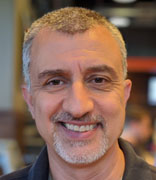Upcoming Webinar: "How the Mobile Phone Became a Camera"

Upcoming Webinar - 21 September 2020
Webinar Topic: "How the Mobile Phone Became a Camera"
Presenter: Dr. Peyman Milanfar
Based on the IEEE Xplore® article
RAISR: Rapid and Accurate Image Super Resolution
published in the IEEE Transactions on Computational Imaging, November 2016
| Presenter: Date: Time: Duration: Register: Download: |
Dr. Peyman Milanfar 21 September 2020 11:00 AM EDT (New York time) Approximately 1 hour Attendee Registration The original article is open access and freely available to download, on IEEE Xplore® |

The IEEE Signal Processing Society would like to express our concern and support for the members of our global community and all affected by the current COVID-19 pandemic. We appreciate your continued patience and support as we work together to navigate these unforeseen and uncertain circumstances. We hope that you, your families, and your communities are safe!
About this topic:
The first camera phone was sold in 2000, when taking pictures with your phone was an oddity, and sharing pictures online was unheard-of. Today, barely twenty years later, the smartphone is more camera than phone. This transformation was enabled by advances in computational photography — the science and engineering of making great images from small form factor, mobile cameras. Modern algorithmic and computing advances, including machine learning, have changed the rules of photography, bringing to it new modes of capture, post-processing, storage, and sharing. This webinar will explore a brief history of digital and computational photography and describe some of the key recent advances of this technology, including burst photography and super-resolution.
About the presenter:

Dr. Peyman Milanfar received his undergraduate degree in electrical engineering and mathematics from the University of California, Berkeley, and the M.S. and Ph.D. degrees in electrical engineering from the Massachusetts Institute of Technology.
He founded MotionDSP, which was acquired by Cubic, Inc. He is a Principal Scientist/Director at Google Research, where he leads the Computational Imaging team. Prior to this, he was a Professor of Electrical Engineering at University of California, Santa Cruz, from 1999 to 2014. He was Associate Dean for Research at the School of Engineering from 2010 to 2012. From 2012 to 2014, he was on leave at Google-x, where he helped develop the imaging pipeline for Google Glass. His team at Google developed the digital zoom pipeline for the Pixel phones, which includes the multi-frame super-resolution (Super Res Zoom) pipeline, and the RAISR upscaling algorithm. In addition, the Night Sight mode on Pixel 3 uses our Super Res Zoom technology to merge images (whether you zoom or not) for vivid shots in low light, including astrophotography.
Dr. Milanfar has been a keynote speaker at numerous technical conferences including Picture Coding Symposium (PCS), SIAM Imaging Sciences, SPIE, and the International Conference on Multimedia (ICME). Along with his students, he has won several best paper awards from the IEEE Signal Processing Society. He is a Distinguished Lecturer of the IEEE Signal Processing Society, and a Fellow of the IEEE “for contributions to inverse problems and super-resolution in imaging.”

